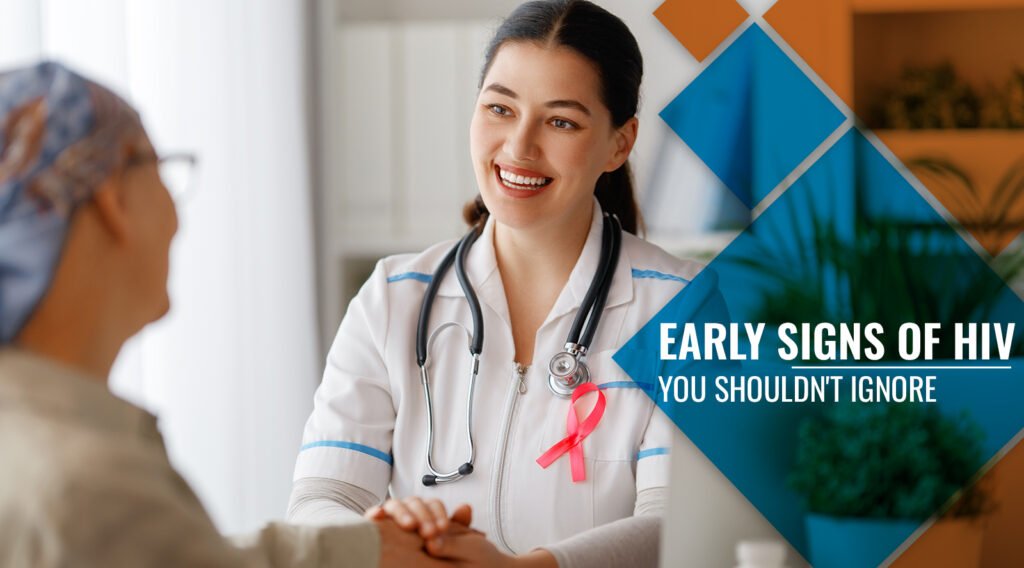The symptoms of HIV generally appear later than expected. However, early signs of HIV are confusing and often mistaken for other ailments. Thus, you need to confirm your HIV status at first place.
If you notice continued illness; consult your healthcare provider at the earliest. The more you delay, the more you put yourself at risk.
In this blog, we have discussed about the common early signs of HIV. So, keep reading and enlighten yourself!
What are the common early signs of HIV?
Early signs of HIV, popularly termed as “acute retroviral syndrome” may manifest with flu-like symptoms such as:
- Headache: It is indicated by a distinct pain at any part of the head. Can affect one or both sides of the head. It can either be localized to a specific area or spread from a focal point. Symptoms can vary from sharp pains to throbbing sensations or dull aches.
- Fever: It is characterized by a temporary rise in body temperature. Acts as a response to disease or illness. It can be accompanied by weakness, body aches, or fatigue. General symptoms are coughing, sore throat etc.
- Extreme tiredness: It is a persistent sense of exhaustion, burnout, or lack of energy. Also known as “fatigue”
- Aches in joint: It is associated with a burning, throbbing, or a “grating” sensation in joints. Additionally, this may lead them to get rigid.
- Reduced appetite: A reduced appetite refers to a diminished urge to eat. In medical terms, this condition is called anorexia.
- Inflamed lymph nodes: This is indicated by swollen, tender lumps in lymph nodes. Occurs as a natural response of the body to illness or infection. It is often very painful.
- Sore throat: It is characterized by discomfort, scratchiness, or irritation in the throat, typically aggravated by swallowing.
The primary cause of a sore throat (termed as pharyngitis) is usually a viral infection, such as a cold or influenza.
- Skin rashes: A rash is an alteration in the skin’s color, appearance, or texture. It can occur in a specific area or cover the entire body.
Rashes may lead to changes in skin color, itching, warmth, bumps, dryness, cracking, blistering, swelling, and discomfort.
- Muscle spasms: These are painful contractions and tightening of muscles.
- Mouth ulcers: These are painful sores that develop inside the mouth. Often surrounded by swollen and red mucous membranes.
- Genital ulcers: These are small lesions that can develop on the vagina, penis, or anus. They are typically caused by sexually transmitted infections.
How long do the symptoms take to appear?
Common early signs of HIV typically emerge between 2 to 4 weeks following transmission. However, some individuals may not exhibit any initial symptoms after contracting HIV.
This virus can persist in its asymptomatic form for a long period of time. This can range from 10 to 15 years; or even more! But this does not indicate the virus has disappeared.
When to reach out for medical help?
It’s crucial to note that your early signs of HIV can resemble those of common illnesses and health issues. Therefore, early detection can always help you in the long run. Reach out for medical help if you are:
- Remaining continuously ill: Consult your primary physician if you are unwell for extended periods.
- Being sexually involved with a suspected individual: If you are sexually related with a HIV-positive person, reach out for medical as fast as possible.
The sooner you are diagnosed with HIV, the sooner treatment can begin.
However, we will always recommend you to get a blood test beforehand. It acts as a confirmatory test for the presence of infection in the bloodstream.
How to test for HIV?
Regardless of whether a person exhibits symptoms, he must get himself tested for viral load. It is a simple blood test which determines the quantity of virus present in your body. A high viral load increases the likelihood of transmitting HIV to another person.
It has the following steps.
- Drawing blood: Your healthcare provider will take some blood out. The needle is generally injected into a vein in your arm.
- Sample collection and testing: This step involves collection of sample blood into a test tube or vial. You may feel a slight sting as the needle is inserted or removed. The procedure typically lasts for under five minutes.
What do the HIV test results indicate?
- A negative or undetectable viral load: This indicates that there is very little virus in your blood, making it difficult for the test to detect.
It denotes that the risk of transmitting HIV through sexual activity is low. However, it does not mean you are cured.
It is therefore advisable that you must continue taking your medications to keep the virus under control.
- A low viral load: It indicates that the virus is under control and being prevented from multiplying. This denotes that your infection is unlikely to progress.
- A high viral load: It indicates that the virus is replicating actively, and your current treatment regimen may not be effective.
A higher viral load increases the risk of infections and diseases associated with a weakened immune system. It may also elevate the risk of progressing to AIDS.
In such cases, your healthcare provider will likely recommend changing your medications.
Treatment procedures
HIV is a non-curable condition. But, with treatment it can be managed. You can prevent its progress to the ultimate stage, with timely tests.
Thus, if you have had a high-risk encounter, seek immediate medical attention from a primary care physician.
There is a lot of budding private sexual health clinics in London now-a-days. You can always opt to visit one and get tested.
The common treatment procedures that the doctors generally implement are:
- Post-exposure prophylaxis (PEP): Medical professionals can prescribe post-exposure prophylaxis (PEP) medication after exposure to lower the risk of HIV infection.
However, this medication needs to start within 72 hours after exposure. The ideal time is the first 24 hours after contracting the virus.
- Antiretroviral therapy: This therapy can result in viral suppression. If you have high levels of viral load, then it may be beneficial.
Antiretroviral therapy includes medications that inhibit the virus from replicating in the body. Thus, it enables the immune system to recover and prevent additional harm.
A combination of HIV drugs is prescribed due to the virus’s ability to adapt rapidly and develop resistance.
When an individual with HIV achieves an undetectable viral load, they cannot transmit HIV to others.
Future prospects
HIV is a complex virus that undergoes rapid mutations. It can evade immune system responses effectively.
At present, there are no vaccines available for preventing or treating HIV. Ongoing research and testing on experimental vaccines continue, but none are nearing approval for widespread use.
Final takeaway
In conclusion, recognizing the early signs of HIV is crucial for timely intervention and management. If you suspect any symptoms or have had a high-risk encounter, seek medical attention promptly. The top private sexual health clinics in London offer comprehensive testing and treatment options to help manage HIV effectively. Early detection and treatment can significantly improve outcomes and reduce the risk of transmission. Stay informed, get tested regularly, and prioritize your sexual health.












































